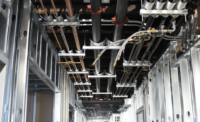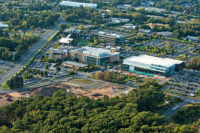Peter Smerud understands the project he’s in charge of is a once-in-a-generation opportunity. This is why he’s swinging for the fences.
Smerud is the executive director of the private nonprofit Wolf Ridge Environmental Learning Center in Finland, Minn., a nearly 2,000-acre, 380-bed campus where kindergarten through high-school students from all over can come throughout the year to learn about nature and beyond.
“This project is taking the next step (for Wolf Ridge),” he says. “We are moving the experience for kids and the parents that accompany them to be more inclusive of educating about how we live inside a building. It’ll show what that building does, the impact it has, show if it is healthy and does it help regenerate our society? Does it take more than it gives?
“We identified a need in our strategic planning to improve our facilities in 2010-11. We needed to upgrade our facilities to better serve our clients.”
Wolf Ridge opened in 1971 and the facility reports more than 15,000 students, teachers and parent chaperones from Minnesota, North Dakota and Wisconsin descend on its campus each school year. During the summer, an additional 3,000 people — including college students — take in events and programs such as wilderness trips, ecology credit camps and family programs at Wolf Ridge.
According to Smerud, the massive project will create a “home away from home” living experience that makes Wolf Ridge attendees “physically and emotionally” satisfied. Smerud and the Wolf Ridge team also wanted to make sure the facility was living up to the standards taught to attendees.
“How were we going to set our measurements?” Smerud asked. “How were we going to evaluate our success?”
Immediately, according to Smerud, third-party verification standards came to mind. He considered achieving the highest possible LEED designation, but a new benchmark was brought to his attention by Wolf Ridge board members. The Living Building Challenge proved to be the right target for Wolf Ridge because it is an international building certification program that promotes the measurement of sustainability in a building – both renovated and new-constructed buildings.
Certification for the Living Building Challenge is based on actual performance where facilities must be in operation for 12 months before evaluation. There are a plethora of criteria that must be met over a consecutive 12-month period for a facility to earn “Living” status — the finish line for Wolf Ridge.
“The board said, ‘If anyone in the world should be doing this, it is us,’” Smerud recalls. “Everything about Wolf Ridge is total immersion learning. No one comes here for just the day. They come here for a week or more.
“The Living Building Challenge is perfect. It fits with our goals.”
Finding a partner
With ambitious goals, Smerud knew he had to find an engineering partner that believed in what Wolf Ridge set out to accomplish. After meeting with firms around the U.S., a common bond was formed between Smerud and nationwide architecture and engineering firm HGA and local engineer Jim Bradburn, P.E.
“One of our principals knew Pete and Wolf Ridge,” Bradburn recalls. “We competed for it and won based on our expertise in sustainable design. Being sustainable obviously is one of Wolf Ridge’s goals.”
Bradburn, who came to the project in January 2015, appreciates the fact Wolf Ridge operators are not looking for the latest high-tech gadgets to be installed.
“They are very practical,” he says. “They want the most effective and simplest way to get things done. That is one of things we kept in mind when we were designing the system. How can we make the systems simple enough that they can be maintained and operated easily?”
In total, the Wolf Ridge project is broken down into three phases. The first was the design and construction of a new maintenance facility and a 6,000-square-foot staff housing building. As soon as the Minnesota weather warms up, the team will put the finishing touches on buildings and prepare for the next step.
Phase Two is the complete renovation of Wolf Ridge’s 20,000-square-foot West Dorm building — a wood structure that will require extensive changes to meet the Living Building Challenge’s criteria.
“We’re going to keep the structure and the floor, but the façade is coming off and the systems are coming out,” Bradburn notes. “We were able to then upgrade the building’s envelope.”
Additionally, a classroom building that is a on a remote site on Lake Superior will be built. It will have composting toilets and its own dedicated HVAC system where the campus buildings are tied into the wood-pellet-fueled central plant.
For the staff housing and West Dorm designs, Bradburn hoped a more complete natural ventilation strategy could be employed, but the surroundings made that impossible.
“We came to find out that we didn’t have the space needed to create enough draft and lift,” he notes.
He had to switch to a mechanically-assisted, passively-cooled system and utilize whole-building ventilation fans.
“We have three units in the West Dorm that turn on and pull the warm air out of the building,” Bradburn says. “If anyone wants cooling in their space they can open the windows.”
In his design, Bradburn was going to put in some automation for the windows before Smerud put up the stop sign.
“He said, ‘No, we don’t need that. We’ll educate our staff and tell them if it is nice out, go ahead and open the window!’” Bradburn recalls with a chuckle.
Between a rock and a hard place
Just below the surface of the Wolf Ridge campus is a thick layer of bedrock that made using rigid pipe a nonstarter due to the amount of fittings that would have to be used and the excavation of rock. Thankfully, Smerud had some excellent experience with Apple Valley, Minn.-based pipe manufacturer Uponor. The manufacturer provided Wolf Ridge Ecoflex back in 1996 for heating and cooling the buildings. More than 20 years later, Ecoflex remained the proper solution for Wolf Ridge’s expansion and the Living Building Challenge criteria. To boot, Smerud notes Uponor donated all of the needed Ecoflex to Wolf Ridge for all the phases of the project.
Bradburn says the contractors had to use some extra precaution when installing the Ecoflex at Wolf Ridge.
“They laid the pipe as deep as they could,” he says. “They know there might be some shallow areas so we have an installation detail that told them to mound up dirt over the pipe. Then they have to put insulation board on the sides and top, and then place more dirt on it.
“There could be some mound snakes going through the site as needed. We realized during the winter we will have heated water running through there so we do not feel there is a freeze issue. But, we will be losing heat to the environment that we don’t need to.”
Bradburn specified Uponor PEX pipe and its manifolds for radiant floor for the new maintenance building at Wolf Ridge. There are two zones in the building — the main service bay and the office/bathroom area — that are served by the Ecoflex from the central plant. The heated water is then distributed among the two zones. Additionally, Uponor PEX is being used for the domestic water and hydronic systems in all the current and future buildings at Wolf Ridge.
“Even with this challenge, the installers were pleased with the PEX installation compared to rigid pipe,” Smerud says. “They dug the trench and flopped the Ecoflex in, thanks to the flexibility of the pipe. I have no concerns because it has performed so flawlessly for us for years.”
Wolf Ridge’s domestic water system also features a Grundfos CMBE water booster pump, a Bradford White Electri-Flex electric water heater and a Bradford White PowerStor2 indirect water heater.
Ready to learn
Smerud and Bradburn worked together and devised a metering system that allows the students to understand how much they play a factor in the sustainability of Wolf Ridge. Bradburn told his plumbing designer, Jeff Ballestreri, there had to be one hot water and cold water takeout for each room.
“That was because there are water meters at each of those locations,” Bradburn states. “We had to think about and be very deliberate about how we laid that out.”
The flow of water is monitored directly, but the heating of each room is monitored by how much time the two-way valve is opened.
“By knowing the temperature difference and the balanced flow we can calculate it,” Bradburn says. “It is much more cost efficient than buying a Btu/h meter for each space.”
In the renovated West Dorm there will be 40-in. monitors that will display the energy readouts for the students to learn about how much energy Wolf Ridge consumes. Additionally, each room will have a 7-in. display that will have something such as a speedometer and an odometer.
“The odometer will show students how much energy and water are used for the week. The speedometer will show what they are using right now,” Bradburn states. “To be able to provide the kids feedback, I believe that is very important. Information is power. The kids will realize they used a lot of water. Maybe they’ll think about how they can change their behavior. They’ll be able to take that knowledge back home with them.”
Smerud adds: “We wanted to push that conservation by providing instantaneous feedback to people. We know from example that kids will ask those questions.”
Bradburn appreciates Wolf Ridge and Smerud’s commitment to sustainability, something that he holds close to his heart, especially within the budget the facility had to offer. Bradburn is excited to get started on the next phases of the project.
Additionally, Smerud’s leadership was incredibly crucial to make everything come together neatly.
“He is very passionate and very involved,” Bradburn says. “Wolf Ridge is a learning laboratory. Peter says, ‘We don’t just want the buildings to be sustainable. We want the people to work with the buildings to make them sustainable.’ He was very committed that a change of behavior was a part of this building.”
The work to provide the best facilities and opportunities for children to learn about nature and their role in the habitats is still ongoing. With Bradburn and HGA, Uponor, other manufacturing partners and a host of others, Smerud is eager to see what the future holds for Wolf Ridge.
“This has been a real team effort,” he states. “It’s pretty exciting.”
This article was originally titled “Living well” in the February 2017 print edition of PM Engineer.








